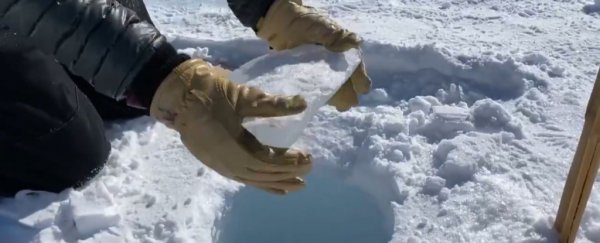Imagine you're a scientist working in Antarctica.
You've suffered through freezing temperatures, drilled ice cores to understand more about our ancient planet, and of course, thrown some ice down a really deep hole to hear it go 'pew'.
Yes, that's the sort of pastime people discover while living in some of the most inhospitable parts of our planet.
Thanks to isotope geochemist John Andrew Higgins on Twitter, you too can experience this weird joy, as researchers have recorded the fantastic sounds of a block of ice falling down a 137-metre (450-foot) drill hole.
What does a 9 inch ice core sound like when dropped down a 450 foot hole? Like this! Credit to @peter_neff for the idea and @Scripps_Polar, @sciencejenna, @GeosciencesPU, @US_IceDrilling, and @paleosurface for the execution! pic.twitter.com/pW7LxKdbUB
— John Higgins (@blueicehiggins) February 7, 2020
Why the heck does it sound so strange?
We have an answer to that thanks to Peter Neff, the glaciologist who may have started the trend of throwing ice down really long drill holes and recording the result.
Back in 2018, Neff recorded a piece of ice falling down a 90-metre (295-foot) bore hole, and that video went viral – amassing 10 million views on Twitter alone.
According to Neff, there are two factors at play here – the Doppler effect and the way sound waves move throughout the hole.
"The first thing you hear as the ice is falling is the pitch of the sound changing," Neff explains in an accompanying video.
"That's the Doppler effect."
You've probably experienced the Doppler effect a lot – it's the reason a car sounds different when it's coming towards you, and then moving away. This great little illustration below shows how sound waves from a moving source change in frequency (and therefore pitch) as they pass.
 (Charly Whisky/Wikimedia/CC BY 3.0)
(Charly Whisky/Wikimedia/CC BY 3.0)
When it comes to the ice however, on top of the Doppler effect, sound waves from the falling material also have a hard time getting out of the hole.
"Then when the ice hits the bottom of the bore hole, the sound doesn't only come straight up - the sound waves start to bounce off the sides of the hole," Neff explains.
"That's why you hear this 'pew!' with sort-of a heartbeat sound afterwards."
You should watch the entire video above to learn more about the noise, and about the science researchers get from drilling these ice cores.
It's also a fantastic reminder that scientists are super creative, and love having fun just as much as the rest of us - and sometimes that means dropping ice down really, really deep holes.
